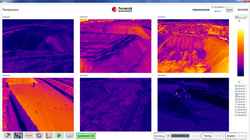
Posted to News on 15th Nov 2017, 16:15
The many benefits of thermal imaging for biofuel fire prevention
The growth in the use of biofuels to generate power has led to an important new application for infrared monitoring. Common biofuel sources such as forestry waste and wood chips are stored in massive heaps but the big problem with these organic materials is the danger of self-combustion. Left unchecked an outbreak of fire can lead to huge production losses and clean-up costs. To mitigate this risk, many facilities are turning to thermal imaging as a cost-effective and efficient method of early fire detection and prevention.

A typical user is the Swedish energy provider, Sderenergi that serves Southern Greater Stockholm. It generates combined heat and power (CHP) from biofuels and recovered fuels. The principal source is forestry waste - tree branches and tree tops - but also wood chips, bark and shavings. Given the nature of these materials the company has installed a monitoring system based on FLIR thermal imaging cameras whose job is to detect any rise in storage pile temperature.
Not only has this system provided much more reliable thermal monitoring of the stock piles but also better fuel management and safer transportation with the added benefit of 24/7 intruder detection.
Historically, Sderenergi engineers inspected the material piles visually and with a temperature probe. Not only was this time-consuming but the probe only gave a reading from one point and was therefore far from comprehensive as a method of detection. Determined to improve the efficiency of the process, the company sought a system that would generate alarms at the earliest stage of a fire in different areas of the fuel terminal. The goal was also to obtain an understanding of how such fires develop in order to be better prepared and more effective at extinguishing them.
The system Sderenergi selected was the "TST Fire' Early Fire Detection System developed by Termisk Systemteknik. The system continuously analyses the thermal camera stream in real time and automatically generates an alarm when a pre-defined temperature threshold has been exceeded. Through sophisticated video analytics, it is also able to suppress unwanted events, for example, vehicles moving in the area.
Central to the TST System are 12 FLIR A615 fixed mounted thermal imaging cameras, that were installed using Sderenergi's existing lighting infrastructure, to monitor the entire eight-hectare site for hotspots and early fires. A key reason for the selection of this model camera was its proven reliability and high resolution. This allowed Termisk to use a minimal number of units to create a highly economical system.
Additional functionality
The TST Fire System with integrated FLIR cameras can also be used to detect site intruders, day and night and in the harshest of weather conditions. This helps Sderenergi to prevent vandalism or theft and ensure the highest level of site safety.
The cameras can also see through smoke so, in the event of the fire, plant managers can monitor firefighting activities. This wasn't previously possible as standard visual cameras were blinded by the smoke.
As different types of biofuels need to be transported via rail or ship to meet the varying energy demands of Sderenergi's customers, the FLIR cameras are helping the operators of the fuel terminal to monitor the temperature of the fuel over time. Importantly, this enables them to make intelligent decisions on transportation.
Olle Ankarling, Sderenergi's Plant Manager explains: "We use the thermal camera system to judge whether a delivery is fit for storage. If we have a load coming in that shows an increased heat pattern, we can take it aside and transport it immediately to the plant without storing it. We can also keep historical data to see how things develop from day to day and week to week. We know it's not the actual temperature on the day that signifies risk but the heat development over time."
The information from the FLIR cameras is continuously combined with the wind, temperature and precipitation data from a weather station. This allows the operators of the fuel terminal, for example, to see how long certain types of fuel can be stored. It's also invaluable information for Sderenergi as it allows the company to work much more efficiently.
Olle Ankarling concludes: "The FLIR cameras have taken away the uncertainty. Before we had them, we never knew when something was going to happen. Today, we are always one step ahead because we can detect hotspots even before a fire breaks out. We know exactly where to look and how to handle the risk."
For more information about thermal imaging, please visit www.flir.com.






























